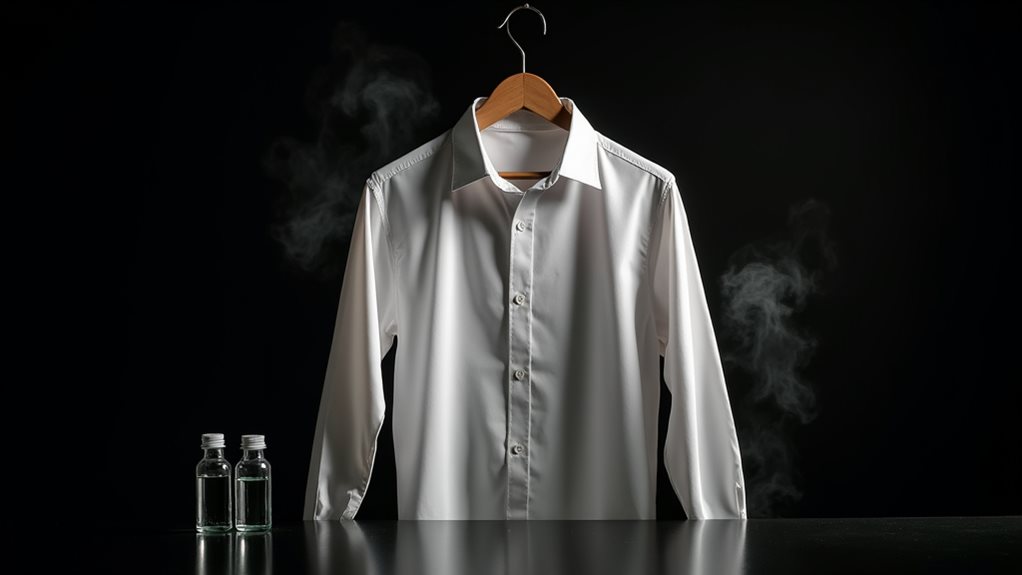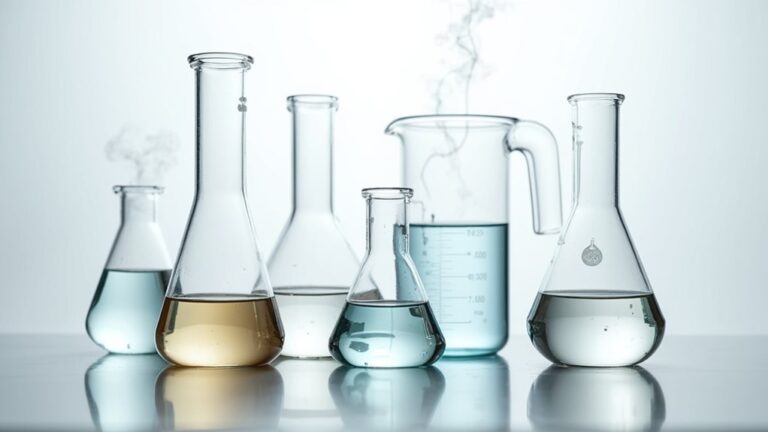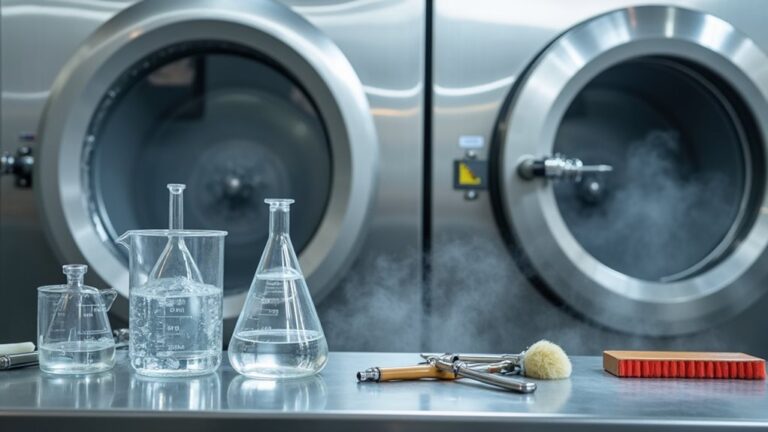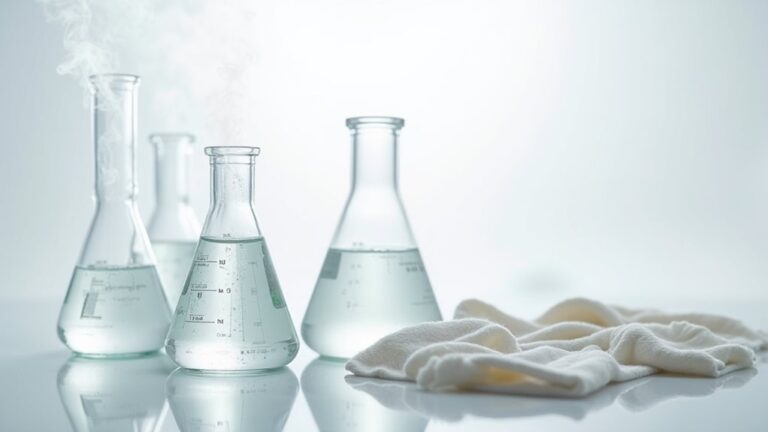Wearing dry cleaned clothes can potentially increase your cancer risk because the chemical solvent PERC, classified by the EPA as a likely carcinogen, often remains on garments after cleaning and releases into your indoor air. While the risk stays relatively low for occasional exposure, regular contact with PERC-treated clothing may contribute to bladder cancer, non-Hodgkin lymphoma, and other health issues over time. Fortunately, you’ve got safer alternatives and protective strategies to explore.
What Is Perchloroethylene and Why Is It Used in Dry Cleaning
The invisible villain lurking in your freshly pressed blazer might surprise you – it’s a chemical called perchloroethylene, though most folks in the industry just call it “perc.”
The hidden danger in your crisp dress shirt could be a toxic chemical most people have never heard of.
I remember the first time I learned about this stuff, feeling a bit like I’d discovered a dirty secret hiding in plain sight, because here’s this incredibly effective solvent that can make your greasiest stains disappear like magic, yet it comes with some seriously concerning health baggage.
PCE works brilliantly at dissolving oils and stubborn spots that water-based cleaning can’t touch, which explains why dry cleaning shops rely on it so heavily.
Unfortunately, this same effectiveness comes with the EPA labeling it a likely carcinogen, and residual perc can stick around on your clothes long after cleaning, creating potential health risks.
Beyond cancer concerns, prolonged exposure to PERC can also cause skin irritation and respiratory issues, making it important to understand what you’re potentially bringing into contact with your body.
Health Risks Associated With PERC Exposure From Clothing

Anyone who’s ever slipped on a freshly dry-cleaned suit knows that distinctive chemical smell, but what most people don’t realize is that this scent represents actual PERC molecules floating off their clothes and straight into their lungs.
When you wear recently dry-cleaned garments, you’re fundamentally carrying a carcinogen around with you, and the health risks from this exposure are genuinely concerning.
The cancer risks associated with PERC exposure include:
- Bladder cancer – Studies show increased rates among those regularly exposed
- Non-Hodgkin lymphoma – Particularly linked to occupational dry cleaning exposure
- Multiple myeloma – Another blood cancer connected to PERC contact
- Liver and kidney damage – Long-term exposure can seriously harm these critical organs
Despite EPA regulations classifying PERC as a likely carcinogen, this chemical continues contaminating indoor air through our clothing.
Beyond cancer risks, PERC exposure has also been linked to neurological problems and reproductive issues, making it particularly concerning for pregnant women and children.
How Toxic Chemicals Remain in Dry Cleaned Garments

While your dry cleaner might proudly hand you those plastic-wrapped garments with a smile, what they’re not telling you is that your clothes are fundamentally mini chemical factories, slowly releasing toxic PERC into your home for days or even weeks after pickup.
The residual presence of PCE in dry cleaned garments creates a sneaky source of indoor air contamination that most people never consider.
Materials like wool and cotton actually hold onto these toxic chemicals more stubbornly than silk, and here’s the kicker – each cleaning cycle can actually increase PCE concentration rather than eliminate it.
This long-term exposure presents genuine health risks and potential cancer risks, which is why regulatory agencies are finally pushing for safer alternatives.
Studies have linked occupational exposure to PERC with increased risks of bladder cancer, esophageal cancer, and cervical cancer among dry cleaning workers.
Regulatory Actions and Current EPA Ban Status

Fortunately, regulatory agencies have finally woken up to what scientists and health advocates have been screaming about for decades, and they’re taking some pretty serious action against PERC in the dry cleaning industry.
The EPA has stepped up big time with regulatory actions that’ll make your head spin in the best possible way.
Here’s what’s happening to protect public health from these carcinogenic chemicals:
- California leads the charge – Complete PERC phase-out in dry cleaning as of January 2023
- National timeline set – EPA’s 10-year plan requires 30-35% of remaining cleaners to stop using PERC by 2034
- Workplace protection boosted – New exposure limits could reduce worker contact by 97%
- Consumer bans expanded – TCE completely banned due to serious health impacts
These changes address decades of concerning exposure to toxic solvents.
As these regulations take effect, consumers can also protect themselves by choosing facilities that use safer alternatives like liquid CO2 cleaning or wet cleaning methods instead of traditional chemical solvents.
Safer Alternatives to Traditional Dry Cleaning Methods

You don’t have to resign yourself to potentially harmful chemicals when caring for your favorite garments, because the dry cleaning industry has adopted several innovative alternatives that protect both your health and the environment.
These safer options include non-toxic solvents like liquid CO2 and silicone-based cleaners, professional green cleaning services that use water-based methods, and surprisingly effective home care techniques that can handle many “dry clean only” items.
For regular garment maintenance, you can also try steam cleaning with high-temperature water vapor, which removes dirt and odors without any chemicals whatsoever.
I’ll be honest – I was skeptical about these alternatives until my neighbor’s wool blazer came back from a green cleaner looking absolutely pristine, which convinced me that you can maintain your wardrobe’s quality while avoiding those concerning PERC fumes.
Non-Toxic Solvent Options
Several innovative cleaning methods have emerged as safer alternatives to traditional dry cleaning, and honestly, learning about these options felt like discovering a hidden world of possibilities I never knew existed.
You’ve got access to non-toxic solvents that won’t expose you to perchloroethylene (PCE) or trichloroethylene (TCE), those nasty chemicals we discussed earlier.
Here are your best cleaning alternatives:
- Wet cleaning – Uses biodegradable detergents and specialized techniques
- Liquid carbon dioxide – Environmentally friendly with zero health implications
- Propylene Glycol Ethers – Completely biodegradable with established safety limits
- Siloxane (D5) – Less aggressive than traditional solvents
The change is happening slowly, but your consumer awareness can accelerate progress.
When you specifically request these methods, you’re voting with your wallet for safer practices.
While many establishments are transitioning to these safer options, petroleum-based solvents remain prevalent in dry cleaning facilities worldwide due to their proven effectiveness and existing infrastructure.
Professional Green Cleaning
When I first walked into a professional green cleaning establishment last year, the absence of that sharp chemical smell immediately caught my attention, and I realized this wasn’t just marketing hype—these facilities genuinely operate differently than conventional dry cleaners.
The dry cleaning industry is finally embracing safer methods that address serious health effects linked to traditional solvents. You’ll find wet cleaning systems using biodegradable detergents, which effectively clean delicate fabrics without carcinogenic chemicals.
Alternatives to PERC, like the GreenEarth® system, offer environmental benefits while maintaining quality results.
With California’s PERC ban leading regulatory changes, these facilities represent more than just trendy marketing—they’re becoming a genuinely safe alternative that protects both your health and our planet’s future. Many cleaners also offer CO2 cleaning as another eco-friendly option that uses carbon dioxide instead of harsh chemical solvents.
Home Care Methods
While professional green cleaning offers excellent alternatives, I’ve discovered that many garments labeled “dry-clean only” can actually be cared for safely at home, eliminating chemical exposure entirely while saving money and time.
These home care methods have transformed my approach to garment care, and honestly, I wish I’d learned them sooner:
- Gentle handwashing with Woolite Extra Delicates works beautifully for most delicate fabrics, avoiding harmful solvents completely.
- Handheld steamers like OGHom models rejuvenate clothes in minutes, removing odors without chemical exposure.
- Dryel At-Home Dry Cleaner Kits provide 20-minute revitalizing cycles that rival professional results.
- Air drying outdoors preserves garment shape while reducing indoor chemical exposure from residual solvents.
When you absolutely need professional services, ask about safe alternatives like liquid carbon dioxide or wet cleaning methods. For those still considering purchasing dry cleaning fluids for home use, be aware that many traditional solvents like perchloroethylene are heavily regulated or restricted for consumer use due to serious health and environmental concerns.
Protecting Yourself From Cancer-Causing Dry Cleaning Chemicals
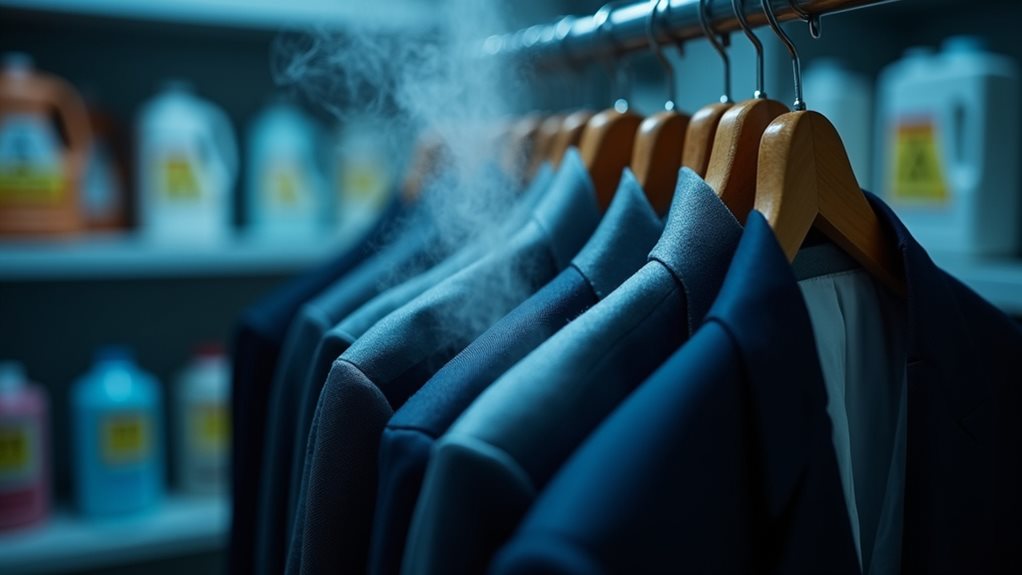
Since discovering that my favorite wool blazer might be harboring cancer-causing chemicals, I’ve become somewhat of a detective when it comes to protecting myself from PERC exposure—and honestly, it’s easier than you’d think once you know what to look for.
Start by asking your dry cleaner about their solvents, because consumer choices drive change, and many shops now offer safer alternatives like wet cleaning or liquid carbon dioxide methods.
Consumer choices drive change—ask your dry cleaner about safer alternatives like wet cleaning or liquid carbon dioxide methods.
When you pick up garments, air them out completely before storing them indoors—I hang mine on my balcony for hours, letting those health risks literally blow away in the breeze.
The Environmental Protection Agency’s working on reducing PERC use, but until then, these simple steps help minimize your exposure to these sneaky chemicals.
While occupational exposure poses the greatest cancer risk for dry cleaning workers, the threat to consumers remains minimal when proper precautions are taken.

